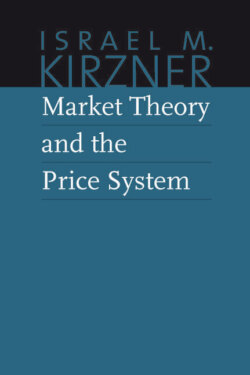Читать книгу Market Theory and the Price System - Israel M. Kirzner - Страница 29
На сайте Литреса книга снята с продажи.
THE MARKET SYSTEM AS A WHOLE
ОглавлениеOur discussion of the pattern of adjustment in the market for a single commodity serves to clarify the nature of the market process as it governs activity throughout the entire market economy. We have seen that it is permissible to consider the market system as a whole, as being made up of many separate markets that have definite and powerful strands of relationship. For the market system as a whole to be in equilibrium, it is necessary for equilibrium to exist within each separate market. Within the market for each commodity, buying and selling plans must dovetail so that no disappointment occurs in the execution of any plan made throughout the system.
So long as the market system as a whole is not yet in equilibrium—that is, so long as “general equilibrium” has not yet been attained—some plans are being disappointed. The disappointed buyers or sellers may revise their plans in several ways. They may offer better terms in the same markets, or they may decide to cease (or reduce) activity in these markets and increase activity in fresh markets altogether. Disequilibrium in any one of the separate markets will thus cause adjustments in the plans made first of all by participants in that market, and then secondarily in the plans made by participants in related markets—whether horizontally or vertically related.
In any event the course of the market process is fairly clear, assuming for the moment that consumer tastes and basic production possibilities are maintained unchanged. As each separate market adjusts to bring correspondence in the buying and selling plans directly affecting it, the ripples of disappointed plans spread gradually into the related markets. Each separate market thus adjusts to disappointments in plans due to both its own initial disequilibrium, as well as to the impact of changes in plans brought about by the adjustments being made in related markets.
In the process of adjustment within each separate market, and between the separate markets making up the entire system, a principal role is played by the entrepreneur. Conditions may exist in separate markets so that adjustments can take place to improve the positions of all concerned. The entrepreneur becomes aware of this situation and undertakes the risk of attempting to make the necessary adjustment. It is through his activity that the relationships between separate markets transmit ripples of change. If, for example, on the market for a finished product, its price is in excess of the sum of the prices of all the resources necessary for its production, as prevailing in the separate resource markets, it is entrepreneurial activity that is at once set into motion by the inconsistency, constitutes itself the condition of disequilibrium, and is responsible for the tendency to bring about ultimate equilibrium in the market.
An important change that occurs at any point in the market system as a whole brings about direct alterations in its immediate market vicinity. Entrepreneurial activity transmits the consequences of these changes to related markets. Through the impersonal medium of altered prices, participants in other, possibly remote, parts of the market system are forced to adjust their plans to the changed conditions. The ceaseless agitation that is characteristic of a market economy becomes now for the market theorist a determinate process that is set into motion in a very definite way in response to fundamental changes in the basic data with which the market grapples. Movements of prices; growth of new industries; expansion or contraction of existing firms; the adoption of new methods of production; the search for new resources, techniques, and products; all become explainable for the theorist in terms of the totality of the market process of which they are a part.
In the next chapter we review briefly what the market process achieves. In the later chapters we turn back to examine in greater detail how market forces are transmitted, make themselves felt, and initiate adjustments. In addition we will see more specifically how each participant in the market economy plays a definite role in the whole process.
